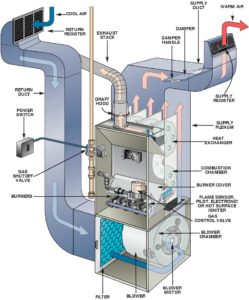A brief rundown of heating methods
In the early years, residents of the United States relied on wood to heat their homes because the continent was covered in forests that made for an easy-to-gather and plentiful supply of fuel, so most homes were heated with a wood burning fireplace or the Franklin stove. Actually, it wasn’t until about 1885 that the country started to burn more coal than wood.
Toward the end of the nineteenth century, the inexpensive cast iron radiator combined with the steel-riveted coal furnace would bring a version of central heat to American homes. These two sources of warmth would be the primary methods of home heating until the mid-1930s when the first forced air furnace that used coal was introduced. Shortly after that, an oil and gas-fired version of the forced air furnace came along and saved families from the task of keeping the fire in the basement burning.
Today, approximately 60 percent of residences are heated with gas furnaces known as FAUs or forced air units. An additional nine percent of the units are oil-fired. In milder climates it’s common to heat homes with a FAUs that use an electric heat pump that supplies both heating and cooling energy.
Moving on to the details
In the earliest days of the nation, brick or stone fireplaces fueled with wood were the primary source of heat. These fireplaces tended to be larger than the ones we use today. In fact, they usually dominated an entire wall of a room. In addition to supplying heat, fireplaces were also used for cooking and heating water for laundry and bathing. Since many homes at the time were single rooms that acted as living and sleeping areas, this type of heating worked very well. However, ventilation tended to be poor, so a great deal of smoke and soot drifted into the room. Fireplaces also became a less efficient form of heat as the size of homes increased.
Which brings our story to the invention of the Franklin stove. It was created by founding father Ben Franklin and was intended to make less smoke and more heat than an open fireplace. The fireplace itself was metal lined with a hollow baffle located near the back. The baffle was intended to transfer more heat to the room’s air using an inverted siphon. By forcing the heat to travel through ductwork, more heat was transferred to the room without all the mess of soot and smoke.
The next improvement came with the combination of the steel-riveted coal furnace and the forced air furnace. This was still prior to the days of electricity being common in all homes, so it depended on natural convection to move the heat through the ducts from the basement unit. The downside to these radiators was that they became extremely hot when they were in use. It is also interesting to note that it wasn’t uncommon in warmer climates to simply use window units that heated or cooled the air in the house.
A short time later, gas or oil filled tanks eliminated the need for coal to be kept in the basement or for anyone to worry about the furnace going out on a cold night. In addition, electricity and the blower wheel moved air from the basement through floor vents and eliminated the need for radiators and soon replaced the coal furnace. This remained the standard until FAU gas and electric units came on the market. These forced air units rely on vents, ductwork and plenums to distribute air and are separate from the heating and air conditioning system. The return plenum takes air from several return grills to a central handler for heating. The supply plenum moves the warm air to the rooms the system is designed to heat.
A heat pump is also a FAU system, but it differs because they are designed to both cool and heat spaces. When used for heating, it utilizes the same type of cycle as a refrigeration system, but it operates in the opposite direction and releases heat into the space. Generally, heat pumps draw heat from external air that is cooler or, in some cases, from the ground.
It was a long trip from the huge fireplace dominating a room to today’s ultra-efficient heating systems that help us to live comfortably in cold weather climates. There are likely newer technologies coming that will utilize geothermal and solar power to make heating homes and businesses less expensive and more efficient.



